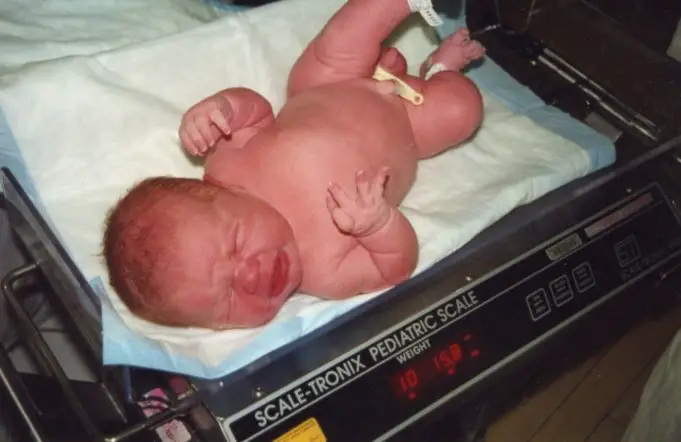Macrosomia is a medical term used to describe a baby that is bigger or weighs more than the average birth weight for gestational age. An average baby weighs between five pounds, eight ounces or 2,500 grams and eight pounds, 13 ounces, or 4,000 grams.
A baby can be said to have macrosomia when she weighs anywhere in the 90th percentile or weighs higher for their gestational age if born at term.
It is estimated that 3 to 15 percent of babies are born with macrosomia. Macrosomia can cause complications during delivery with an increased chance of injury to both mother and child and sometimes may result in cesarean delivery (C-section).
A newborn with macrosomia may also develop some other health conditions later in life, such as diabetes or obesity.
What are the risk factors and causes of macrosomia?
Many things influence your baby’s size. Sometimes, your health care provider may not be able to diagnose the reason that your baby is big, but the following can play a significant role in macrosomia:
- Obesity in the mother
- Diabetes in the mother
- Genetics
- An underlying condition in the baby
Your baby is more likely to develop macrosomia if you;
- Gained too much weight during your pregnancy
- Have high blood sugar before becoming pregnant or developed it during pregnancy (gestational diabetes)
- Are overweight or obese before you became pregnant
- Have had a child with macrosomia or a family history of big babies
- Are up to two weeks past your due date
- Are over the age of 35
What are the symptoms of macrosomia?
The only symptom of macrosomia is birthing a child that weighs more than 8 pounds, 13 ounces – notwithstanding whether the baby was born before, on, or after the due date.
How can macrosomia be diagnosed?
Macrosomia isn’t officially diagnosed until the child is born and placed on a scale as it may be challenging to determine the weight of the child while you’re still pregnant. However, doctors can estimate your baby’s size through the following.
- Going over your medical history and previous pregnancies
- Fundal height measurement. During one of your routine checkups, your healthcare provider may measure the length from the top of your growing uterus to your pubic bone. Having a larger than normal fundal height may indicate a big baby.
- Checking amniotic fluid levels. A higher amount of amniotic fluid – the fluid that surrounds and protects the baby during gestation – is an indication of macrosomia. This is known as polyhydramnios.
- Nonstress test. This test is used to check your child’s heartbeat rate when he or she moves.
- Ultrasound. This test creates an image of the baby in the uterus using sound waves. While it cannot accurately predict the birth weight, it can estimate whether the child is too large in the womb.
- Biophysical profile. The test combines an ultrasound with the nonstress test to measure your baby’s breathing, movements, and amniotic fluid level.
How does macrosomia affect delivery?
Macrosomia can cause the following problems during delivery:
- The baby may experience difficulty passing through the birth canal or even get stuck at the shoulders.
- Labor may take longer than is required.
- The baby may sustain a fracture in his/her clavicle or another bone.
- Vacuum or forceps delivery is needed.
- The baby may not get enough oxygen.
- Cesarean section may be required.
If your doctor feels your baby’s size could complicate vaginal delivery, he may advise that you schedule a cesarean delivery.
What are the complications to mother and baby?
Macrosomia can cause the following complications to the mother:
- Injury to the vagina. During a vaginal delivery, the baby can tear the mother’s vagina or perineal muscles – the muscles between the anus and vagina.
- Bleeding after delivery. A baby with macrosomia can prevent the uterine muscles from contrasting as they should after childbirth, which may lead to excess bleeding.
- Uterine rupture. The uterus can tear during delivery if the mother has had a uterine surgery or a cesarean delivery in the past. This condition could be fatal.
The following problems may arise in the baby:
- Abnormal blood sugar. Some babies with macrosomia are born with lower than normal blood sugar levels, or less often, high blood sugar.
- Babies born large are more likely to develop obesity during childhood.
Babies born at a heavier weight are at risk of developing the following conditions in adulthood:
- Obesity
- High blood pressure
- Diabetes
They are also more prone to developing metabolic syndrome. This group of conditions includes excess fat around the waist, high blood sugar, abnormal cholesterol levels, and high blood pressure.
As the child grows older, metabolic syndrome can increase their risk for conditions like heart disease and diabetes.
How can macrosomia be prevented?
Mothers can reduce the risk of having a big baby by doing the following:
- Maintain a healthy weight throughout your pregnancy
- Get early prenatal care.
- Keep blood sugar in check if you have diabetes.
- Exercise as advised by your healthcare provider
Some key questions to ask your doctor
If your baby is diagnosed with macrosomia during your pregnancy, here are some key questions to ask your healthcare provider:
- What can I do during my pregnancy to stay healthy?
- Will I need to make any changes to my activity level or diet?
- How will a big baby affect my delivery, and how could it affect the baby’s health?
- Will a C-section be necessary?
- What special care will I and my baby need after delivery?
Outlook
It is perfectly fine to worry about your baby’s size as you draw closer to your delivery date. The thought of giving birth to a big baby or having a cesarean delivery would make you nervous.
But, keep in mind that estimates of your baby’s weight may not always be accurate, and your delivery date could be off, as well.
If you are nervous about your delivery and concerned about you and your child’s health, you can go over your options with your doctor to help plan and manage the delivery. With sound information, monitoring, and care, most big babies are born safely and without serious or long-term complications.
References;
- Fetal Macrosomia: Risk Factors, Maternal, and Perinatal Outcome – AJOL
- Large-for-Gestational-Age (LGA) Infant – MERCK MANUAL
- Macrosomia – Winchester Hospital
- Fetal Macrosomia: Risk Factors, Maternal, and Perinatal Outcome – NIH
- Fetal macrosomia: a problem in need of a policy – OBGYN
- Prediction and prevention of the macrosomic fetus – ScienceDirect












